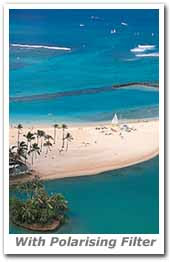.
Photography Advice Corner
Christoph:
I’m very new to photography and I’ve discovered a whole new world, looking through the lens. The problem I am having is with reflections when I shoot around water – like ponds. I would like some of the underwater vegetation and beautiful stones to show, but they don’t appear in my photos. What am I doing wrong? – Cynthia Adams, Arkansas.
Hello Cynthia...
This is a common problem, and you are not doing anything wrong. Without getting into the technical details of light (how it gets reflected and absorbed), let’s keep it simple. To solve your problem, what you and every photographer should have is a polarizer filter. You can get them at your favorite photo store.
Christoph:
I’m very new to photography and I’ve discovered a whole new world, looking through the lens. The problem I am having is with reflections when I shoot around water – like ponds. I would like some of the underwater vegetation and beautiful stones to show, but they don’t appear in my photos. What am I doing wrong? – Cynthia Adams, Arkansas.
Hello Cynthia...
This is a common problem, and you are not doing anything wrong. Without getting into the technical details of light (how it gets reflected and absorbed), let’s keep it simple. To solve your problem, what you and every photographer should have is a polarizer filter. You can get them at your favorite photo store.
As with any filter which is placed in front of your lens, you will lose some image quality. However, it is just a matter of degree. Professional photographers purchase the most expensive multicoated glass filters they can afford. They can range from $180 and up. Amateurs don’t need that kind of quality (unless they demand it), and you can get a good general purpose filter from these brands – Hoya, Tiffen, Cokin and Lee. One of the best in the world is B+W – but, also expensive.
Since you did not mention what lens you have, I can only give you some generalities, but these will apply to all. I am also assuming you have an autofocus lens. When talking to your photo sales representative, ask him/her for a “circular” polarizing filter, with a thread to match your lens.
Become aware of the following general rules:
1. You will need from 1 to 2 additional shutter or f/stops of light…
2. A polarizer filter will generally not work well with “wide angle” lenses (below 17mm)…
3. For maximum effectiveness, shoot your scene at a 90° angle to the sun (have your shoulder aiming toward the sun)…
4. When you aim at a scene or subject, rotate your filter 360 degrees to see its affects…
5. If you purchase an inexpensive filter (private label), you may get some color tinting…
6. DO NOT purchase a ”thin” filter, unless specifically required, due to using a wide angle lens; you may also not be able to mount your lens cap properly, due to lack of sufficient threads on the filter; polarized skies will not be represented well in panoramas…
7. Save your money, do not purchase a third party, private label or off-brand filter costing less than approximately $80…
8. A good quality filter is always “multicoated”.
When using a quality polarizing filter, you can expect the following:
1. The sky will become more saturated and richer in color…
2. Water, glass and metallic surfaces will lose most, if not all, of their glare…
3. Foliage will become more intense in color and shadow areas will become darker…
Courtesy Hoya Filters
This is just a brief guide. Many good sites are available for more detail and technical information. The safest place to start out for accurate information is at an original manufacturer’s site. Unfortunately, there is too much bad / wrong information on the internet.
I personally use B+W Kaesemann circular polarizer coated glass filters. These are quite expensive, but required in my work.
Christoph













No comments:
Post a Comment